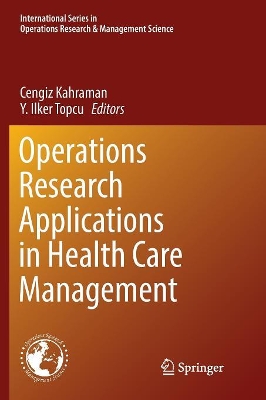Managing Length of Stay Performance
Managing Length of Stay Performance
Top 10 Practical Steps for Reducing the Utilization of Clinical Services
Birjandi, Ali
Taylor & Francis Ltd
01/2026
200
Mole
Inglês
9781138742369
Chapter 1: Importance of LOS and how to measure it
Many organizations don't understand the impact of LOS in an organization. Additionally, most organizations don't know how to measure LOS appropriately. Understanding the nuances of what should be and not be included in the measure is critical to knowing how to manage it.
Defining LOS as an opportunity
Common methods of measuring LOS and GLMOS
What items should be included and excluded from the measure
Common mistakes in measuring LOS
Chapter 2: How to create the infrastructure to roll out the changes
Organizations require significant infrastructure in order to roll out a sustainable LOS program in their organizations. Building all the components from the ground up is critical to get the organization firing on all cylinders to keep LOS down.
Developing the steering committee
Developing the working group
Developing the teams
Developing the meeting schedules and project tracking
Chapter 3: Negotiating with payors to improve approvals
If the payers are not cooperating or you are not negotiating well, the organization will never achieve GMLOS. Knowing what to ask for is critical and getting it into the contract even more so.
Collecting performance indicators for approvals
Setting the required standards for approvals
Meeting with the payors
Negotiating the contracts
Chapter 4: Utilizing hospitalist to manage "inlier" patients
The utilization of hospitalist is critical because an organization has control over them. For the first time the priority of an organization can be part of play in getting LOS down to GMLOS.
What are inliers and how to identify them
Significance of managing inliers
Utilization of hospitalist in managing inliers
Specific information required to manage the hospitalists for LOS
Chapter 5: Setting up post-acute care services to manage "outlier" patients
The most expensive place to treat the patient is in the acute care setting. Any other location will by default be less costly. Knowing clinically when to transition the patient to the right level of care is critical.
What are outlier patients and how to identify them
Significance of managing outliers
Negotiating with post-acute care services
Setting up communication forms with post-acute care facilities
Chapter 6: New innovative reports for managing ALOS and its process
A new level of performance requires newer innovative reports. Reports showing utilization patterns of providers, LOS broken down by inliers and outliers, discharge patterns, and operator discharge times are critical to managing every aspect of the discharge.
New processes require new reporting
How to use these reports
Troubleshooting LOS using reports
Ranking opportunities using reports
Chapter 7: Inter-disciplinary review structure that provides the most benefits
Daily reviews are critical to keep tabs on the patient's condition. The escalation is critical to enable the IDR to function effectively.
Do you have all the right people at the table?
What is the expectation of the team?
When and where are they meeting?
Creating an escalation process.
Chapter 8: Getting the benefits of reducing LOS
It's one thing to reduce LOS but it needs to work in conjunction with labor and non-labor to get the benefits. For the department is not staffing to volumes the cost structure will change.
What does LOS mean to resources
Metrics to track for benefits (labor and non-labor)
Tracking readmissions to make sure LOS is not pushing too hard
Quantifying avoidable days
Chapter 9: LOS management is a perpetual process
Sustainability for LOS requires constant vigilance. Infrastructure that is constantly monitoring the metric is critical. These metrics need to be monitored in conjunction with reciprocating metrics such as 30 day re-admissions to make sure LOS is not decreased at the expense of patient condition.
What happens when the team disbands
Components that need to be in place for CQI process
Monitoring at each level of management
Making it part of the culture
Chapter 10: Leadership drives culture and results through proper communication
The most critical part of the book is making sure you have the right leadership in place. What are the characteristics of a good leadership that can drive the culture.
The value of strong leadership
The communication methodology
Chapter 1: Importance of LOS and how to measure it
Many organizations don't understand the impact of LOS in an organization. Additionally, most organizations don't know how to measure LOS appropriately. Understanding the nuances of what should be and not be included in the measure is critical to knowing how to manage it.
Defining LOS as an opportunity
Common methods of measuring LOS and GLMOS
What items should be included and excluded from the measure
Common mistakes in measuring LOS
Chapter 2: How to create the infrastructure to roll out the changes
Organizations require significant infrastructure in order to roll out a sustainable LOS program in their organizations. Building all the components from the ground up is critical to get the organization firing on all cylinders to keep LOS down.
Developing the steering committee
Developing the working group
Developing the teams
Developing the meeting schedules and project tracking
Chapter 3: Negotiating with payors to improve approvals
If the payers are not cooperating or you are not negotiating well, the organization will never achieve GMLOS. Knowing what to ask for is critical and getting it into the contract even more so.
Collecting performance indicators for approvals
Setting the required standards for approvals
Meeting with the payors
Negotiating the contracts
Chapter 4: Utilizing hospitalist to manage "inlier" patients
The utilization of hospitalist is critical because an organization has control over them. For the first time the priority of an organization can be part of play in getting LOS down to GMLOS.
What are inliers and how to identify them
Significance of managing inliers
Utilization of hospitalist in managing inliers
Specific information required to manage the hospitalists for LOS
Chapter 5: Setting up post-acute care services to manage "outlier" patients
The most expensive place to treat the patient is in the acute care setting. Any other location will by default be less costly. Knowing clinically when to transition the patient to the right level of care is critical.
What are outlier patients and how to identify them
Significance of managing outliers
Negotiating with post-acute care services
Setting up communication forms with post-acute care facilities
Chapter 6: New innovative reports for managing ALOS and its process
A new level of performance requires newer innovative reports. Reports showing utilization patterns of providers, LOS broken down by inliers and outliers, discharge patterns, and operator discharge times are critical to managing every aspect of the discharge.
New processes require new reporting
How to use these reports
Troubleshooting LOS using reports
Ranking opportunities using reports
Chapter 7: Inter-disciplinary review structure that provides the most benefits
Daily reviews are critical to keep tabs on the patient's condition. The escalation is critical to enable the IDR to function effectively.
Do you have all the right people at the table?
What is the expectation of the team?
When and where are they meeting?
Creating an escalation process.
Chapter 8: Getting the benefits of reducing LOS
It's one thing to reduce LOS but it needs to work in conjunction with labor and non-labor to get the benefits. For the department is not staffing to volumes the cost structure will change.
What does LOS mean to resources
Metrics to track for benefits (labor and non-labor)
Tracking readmissions to make sure LOS is not pushing too hard
Quantifying avoidable days
Chapter 9: LOS management is a perpetual process
Sustainability for LOS requires constant vigilance. Infrastructure that is constantly monitoring the metric is critical. These metrics need to be monitored in conjunction with reciprocating metrics such as 30 day re-admissions to make sure LOS is not decreased at the expense of patient condition.
What happens when the team disbands
Components that need to be in place for CQI process
Monitoring at each level of management
Making it part of the culture
Chapter 10: Leadership drives culture and results through proper communication
The most critical part of the book is making sure you have the right leadership in place. What are the characteristics of a good leadership that can drive the culture.
The value of strong leadership
The communication methodology












